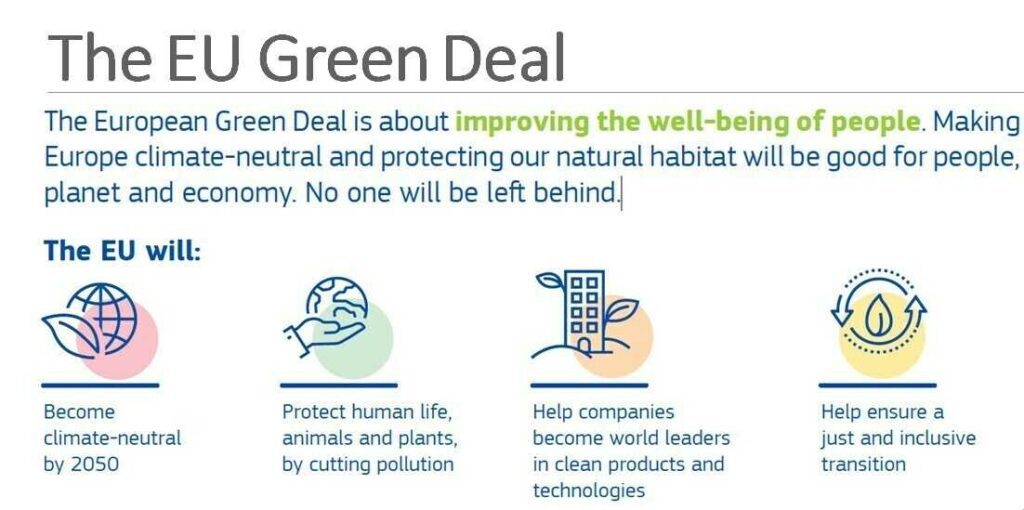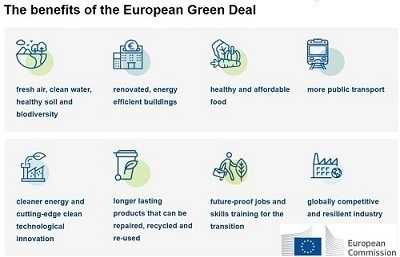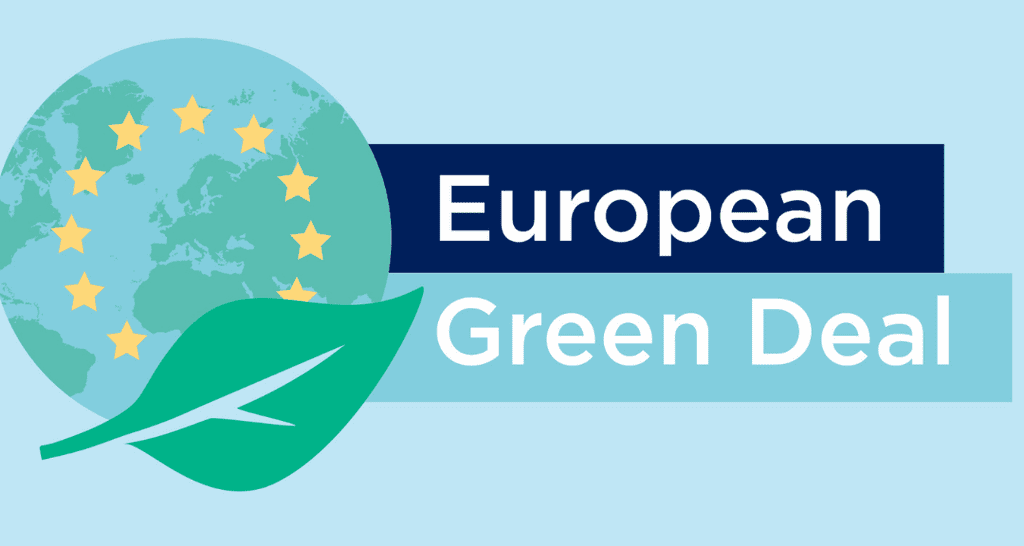What are the implications for companies regarding the European taxonomy: classification, transition to green finance…
EU Taxonomy : Accelerating the Green Digital Transition
_
The European Union has heeded the IPCC’s call and is taking steps to reduce greenhouse gas emissions by 50% in just 10 years and to reduce them completely within 30 years, i.e. by 2050, under the Paris Agreement. How does it plan to achieve these goals? Firstly, by encouraging the financial world to invest massively in the ecological transition, and secondly, by imposing on companies a method of classifying their activities. To do this, it is providing itself with new tools. In order to clarify and improve the quality of information for investors, it has developed the European Taxonomy, which is one of the foundations of green finance. The implications for companies are numerous._
Definition: What is the EU’s Green Deal?
Under the Green Pact for Europe or Green Deal (2019-2024), Europe wants to establish an ambitious new strategy for combating and adapting to global warming, enabling climate neutrality by 2050, while creating jobs and improving quality of life. This is a “new regulatory paradigm”, which aims to prevent “greenwashing” by ensuring that investors and regulators have the right level of transparency and quality of extra-financial data. By regulating the finance sector, it aims to direct capital flows towards activities that reduce our carbon emissions and contribute to Europe’s adaptation to global warming (green finance). It is for this reason that it has adopted regulatory tools for finance, to make it greener.
What are the regulatory tools for green finance?
The SFDR (Sustainable Finance Disclosure) regulation
On March 10, 2021, the European Sustainable Finance Disclosure Regulation (SFDR) on sustainability reporting in the financial services sector came into force. This regulation aims to harmonize and strengthen the transparency requirements for financial advisors and actors marketing certain financial products (such as labels or green bonds).
The CSRD
The CSRD directive updates the NFRD regulation, in order to specify the quality of the information to be provided in the extra-financial ESG (environmental, social and governance) performance declaration of companies. 50,000 companies will be affected by 2023. The launch of the impact.gouv.fr platform aims to guide companies in carrying out this reporting. This directive will require companies to include non-financial performance objectives (sustainable development) in their strategic governance. It will also require management teams to be actively involved in defining, implementing and steering this sustainable development strategy. It will imply an additional degree of commitment and depth in the communication with all stakeholders. In addition, it will involve measuring 47 performance indicators. The structuring, relevance and quality of information feedback will be one of the challenges of the application of this regulation and to do this, the EU is setting up the European taxonomy. To go further: Did you say CSRD?
The European Single Electronic Format (ESEF)
Since January 1, 2020, the annual financial reports of companies listed in the European Union are presented in a harmonized electronic format: the ESEF (European Single Electronic Format). This directive issued by the European Commission aims to harmonize annual financial reports to facilitate their readability and comparison.
Dates to remember:
· 1er January 2022: First disclosure of the taxonomy alignment rate for products affected by sections 8 and 9 of the SFDR. This disclosure of taxonomic alignment concerns the climate theme (mitigation and adaptation to climate change).
· January 1, 2023: Publication of the rate of alignment with the taxonomy extended to the 4 other environmental objectives, still for the products concerned by articles 8 and 9 of the SFDR.
AMF thematic file https://www.amf-france.org/fr/actualites-publications/dossiers-thematiques/esef
Climate risk and duty of care
At the industrial level, throughout its value chain, the company will now have to ensure that its stakeholders are not likely to be disrupted by a natural or climatic disaster (floods, droughts, tornadoes, heat waves, pandemics, soil degradation and depletion, etc.) under the duty of vigilance. This is taken into account with respect to human rights and CSR.
Small precision : Green finance vs. solidarity finance
Be careful not to confuse it with what is called solidarity finance, which is a subset of sustainable finance, corresponding to all the mechanisms and institutions applying the principles of the social and solidarity economy to the financial sector, in which the social aspect is predominant. The companies in this sector have integrated social and societal impact into their governance through their “mission” or “raison d’être” oriented statutes.

What is the European taxonomy?
A sort of encyclopedia of economic activities based on science, which lists and classifies all economic activities in the European Union by sector of activity, according to their degree of contribution to the Net Zero Emissions performance objectives.
What are the categories of taxonomy?
This taxonomy is broken down into the following six themes:
1. Climate change mitigation,
2. Sustainable use and protection of water and resources,
3. Protection and restoration of biodiversity and ecosystems,
4. Pollution prevention and abatement,
5. The transition to a circular economy
6. Adaptation to climate change
In order for companies to be eligible for the taxonomy, they must not only offer an activity present in this repository, but also :
· That they do not cause collateral damage. This is the principle of the DNSH “Do No Significant Harm” (does not produce environmental and social damage);
· That they respect fundamental human rights (for example, a company that manufactures solar panels can only be eligible if the pollution emitted by this manufacture is controlled by waste recovery and compensation, on the one hand, and if the panels are not manufactured by workers subjected to forced labor, on the other hand).
Thanks to this classification, the company will be able to better communicate on the greenest part of its current or future activity, by indicating its share of “green” turnover and its investments.
It allows the assessment of the sustainability of 90 economic activities, representing more than 93% of the European Union’s greenhouse gas (GHG) emissions, according to different levels:
· Activities that are already considered low-carbon and compatible with the Paris Agreement (e.g. low-carbon transportation);
· Activities that contribute to the transition to a Net Zero Emissions economy in 2050 despite both economic and technological obstacles (e.g. building renovation);
· Activities that enable the “greening” or reduction of emissions from other activities, such as the development of technologies that result in substantial emission reductions in other sectors (e.g., wind turbine manufacturing plant).
Each of these activities corresponds to a NACE code. Eventually, we will have an instruction manual for each activity in the European Union.
After examining the recommendations of the Sustainable Finance Platform (SFP) report, the European Commission will give its opinion on the extension of the current taxonomy to non-green sectors, as well as on the inclusion of social objectives.
Who is concerned by the European Green Deal?
The Green Taxonomy currently addresses more than 11,000 stakeholders who check these boxes:
- Large companies with more than 500 employees (with a balance sheet of more than 20 million euros or a turnover of more than 40 million euros)
- Financial institutions: 4 types of players: asset managers, banks, insurers and investment companies
- Member States when establishing public measures, standards or labels for green financial products or greenbonds.
In 2022, large companies with more than 500 employees and financial institutions must publish the portion of their activities and/or investments eligible for the taxonomy. From 2023 onwards, large companies must also publish the alignment of their activities with the taxonomy. Also, starting with the 2024 reporting (based on the year 2023), this taxonomy will be extended to 50,000 actors, as part of the Corporate Sustainability Reporting Directive (CSRD).
But that’s not all! You are also concerned by this subject if your company does not correspond to these criteria, but is part of :
- From a large group (international or not)
- A SRI investment fund in which financial actors can request extra-financial data
- A supplier or service provider of one of the eligible companies
Thus, in the long run, almost everyone will be concerned, whether directly or indirectly.
What are the risks of not considering taxonomy?
The benefits of complying with this regulation are numerous.

Companies that do not comply will eventually suffer from financing and recruitment difficulties and will have difficulty finding suppliers, since all stakeholders, first and foremost investors, will seek out the companies that perform best financially and in terms of ESG criteria. Moreover, since greenwashing is more easily identifiable, ignoring it could damage the company’s reputation.
How to prepare your project for eligibility to the European taxonomy?
Not all economic activities are covered by the taxonomy. An alignment analysis must therefore start with an eligibility analysis (mandatory since 2022). Since 2021 and until 2024, companies are given a transition time to prepare for taxonomy eligibility, to be ready to respond to an audit. PwC France’s accounting experts explain the process of preparing the DPEF (declaration of extra-financial performance), in two interviews on the Editions Législatives channel.
Anne Jeudi de Grissac, partner in the Capital Markets & Accounting Advisory services, and Anne Lenglet, Director of Sustainability Reporting at PwC, explain that for many groups, this transitional period allows them to understand the issues, what needs to be produced, what information is required, what this implies for CSR and to appropriate new concepts between eligible activities and alignment. There is an important step to take. Some companies are going further by looking at the notion of substantial contribution, to be able to identify all the additional notions to be analyzed in 2023. We are dealing with a new, imperfect and complex regulation. We have to be pragmatic and transparent in the way we were forced to calculate, the shortcuts we had to take, or the judgments we had to make to obtain this information. When it comes to KPIs, there is an abundance of “green” and “sustainable” terminology, so be careful, an eligible turnover is not equivalent to a sustainable turnover, which is linked to the notion of alignment.
Taxonomy: how to carry out your EPFD (1) Olivier Muller, Director of the Sustainable Development Department, PwC, explains the steps to prepare your eligibility.
1. First, we will look at the list of eligible activities one by one, to see if the company is concerned by one of them.
2. If this is the case, it will be necessary to retrieve information on the associated revenues (sales), Capex (investment income) and Opex (operating expenses)
3. On the other hand, if we are not concerned by the headings of the Climate Delegated Act, we must still collect information on Capex and Opex (plans and investments that may be eligible).
Eligible investments are all eligible activities that are not directly part of the company’s business. For example, if a company allows its employees to have an electric car as part of their activity, insulates buildings, installs solar panels on its roofs or carries out renovations (regardless of its activity), these investments can be taken into account. These are the activities that a company implements to reduce its impact on global warming. The difficulty is that we are often dealing with an activity that is partly eligible and partly not. For example, in a customer contract, one part is eligible and the other is not, so companies are obliged to make extrapolations and explain them in the EPFD.
**
Then, we will look at the KPIs taken into account**
Taxonomy: how to carry out your EPR (2) According to Anne Lenglet, Director of Sustainability Reporting at PwC, even if the vocabulary and concepts are new, for many of the indicators, we already have the answers in the company’s accounts. However, there are new KPIs to take into account. The numerator (taxonomy) is the real novelty, because it touches on the notion of eligibility. And so, we’re only going to put in what’s eligible. We have to stick to the notion of consolidated turnover, which corresponds to our activity. So we have to go into the mesh of our business sector at a rather subtle level of granularity. There are three types of CAPEX concerning sustainability:
· Capex related to a sustainable activity
· Capex related to a plan to make a business sustainable
· Capex individually sustainable
So, it is possible that my consolidated turnover is not eligible, but that I have eligible Capex and Opex.
Opex is the only KPI for which an exemption can be used if the denominator is not significant, because it is not material. It is necessary to take stock of the information systems, accounting or management, available to date. Then, it will be necessary to set up tables to collect new information (Excel file or software).
How to align with the taxonomy?
The company is qualified as sustainable if it meets these three criteria:
· Eligible economic activities of organizations and investments of financial institutions must substantially contribute to at least one of the six environmental objectives of the taxonomy
· This contribution must be achieved without detracting from the other objectives of the taxonomy. This criterion will be assessed qualitatively and quantitatively against the thresholds and methodologies described in the taxonomy for each objective.
· It respects social and labour rights
In conclusion, we could say that this taxonomy is a historic innovation in accounting and finance and that it constitutes a source of opportunities for companies that invest in CSR. It allows us to value and recognize performance criteria that until now have not been sufficiently taken into account in the overall performance of financial actors, states and companies. Even if it is a challenge to take up, this exercise will allow you to discover unsuspected potentialities to renew or sustain your activity.
Author : Marie-Christine Aubin
To go further :
Frequently asked questions to the Autorité des marchés financiers (AMF): https://www.amf-france.org/fr/actualites-publications/dossiers-thematiques/esef/esef-vos-questions-frequentes#Questce_quESEF_
AMF thematic file: https://www.amf-france.org/fr/actualites-publications/dossiers-thematiques/esef
Mazars’ complete file on the European taxonomy https://www.mazars.fr/Accueil/Services/Transformation-durable/Integration-de-la-Taxonomie-europeenne?gclid=Cj0KCQiA1NebBhDDARIsAANiDD1akWYcyvbPunia_RqliYNfphem44jCIjeDbG5o3VYGB_ElYth6d5caAsmOEALw_wcB
CSR, a European issue https://www.strategie.gouv.fr/infographies/rse-un-enjeu-europeen

